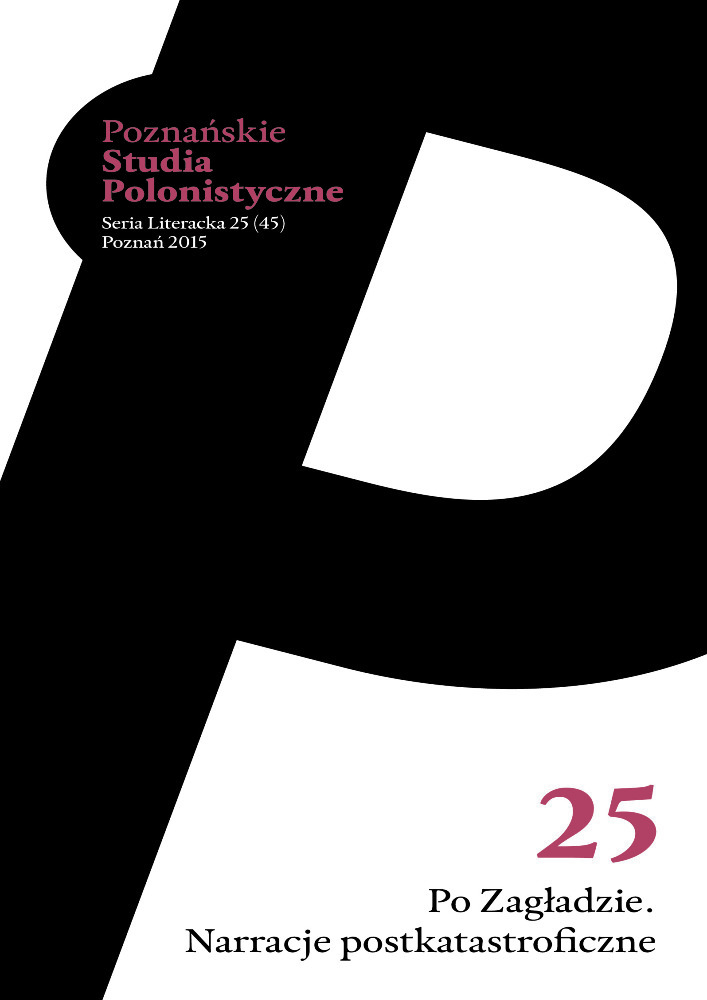Abstract
As far as the question of the Holocaust is concerned, the Polish culture is characterised by some peculiar feature. On the one hand, it embraces the texts which quite uncompromisingly describe the Polish role in extermination, noticing a continuum between collective discriminating behaviours of the non-Jewish part of the society and the exterminating activities of the Nazis. Such voices deconstruct narration, in which the Polish majority remains an isolated, bystanding and passive witness of the Holocaust, and demonstrate some forms of participation. On the other hand, the message of this kind does not permeate into social consciousness, does not become known and does not improve the knowledge of the society about itself. The studies of Protest by Zofia Kossak-Szczucka and Wielki Tydzień (“Holy Week”) by Jerzy Andrzejewski are used for the description of the mechanism of this “becoming acquainted”. A key role in this mechanism is played by preoccupation with self-image of the group. The Holocaust, to a certain degree, undermined the obviousness of Polish discriminating practices towards Jews. In the awareness of elites there appeared a premonition of other criteria of evaluation of Polish behaviours, going beyond the mentioned practices (a phantasm “eyes of the world”). In the light of such criteria, the attitude towards exterminated Jews proves to be discrediting. At the same time, there appear narrations whose aim is to restore the order of discrimination and the hierarchies connected with it, which comes down to forcing the victims into inferior position—in contrast to the dominating majority—and concealing the knowledge about participation in the crime. Consequently, culture remains in the state of unrest. Unwanted knowledge (and the feeling of guilt) returns and the attempts to become purified by the renewed concealment and repudiation of the awareness of evil always prove unsuccessful. The signs of repudiation are the recurring symptoms and repetitions of the same scenario of denial of never clearly stated accusations.References
Andrzejewski Jerzy (1954), Wielki Tydzień, w: tegoż, Noc, Wydawnictwo Literackie, Kraków, s. 69-241.
Błoński Jan (1987), Biedni Polacy patrzą na getto, „Tygodnik Powszechny”, nr 2, s. 1, 4.
Błoński Jan (1996a), Biedni Polacy patrzą na getto, Wydawnictwo Literackie, Kraków.
Błoński Jan (1996b), Polak-katolik i katolik-Polak, w: tegoż, Biedni Polacy patrzą na getto, Wydawnictwo Literackie, Kraków, s. 37-53.
Bourdieu Pierre (2004), Męska dominacja, przeł. Lucyna Kopciewicz, Oficyna Naukowa, Warszawa.
Bourdieu Pierre (2006), Medytacje pascaliańskie, przeł. Krzysztof Wakar, Oficyna Naukowa, Warszawa.
Buryła Sławomir, Krawczyńska Dorota (2012), Proza, w: Literatura polska wobec Zagłady (1939-1968), red. Sławomir Buryła, Dorota Krawczyńska, Jacek Leociak, Fundacja Akademia Humanistyczna, Wydawnictwo IBL PAN, Warszawa, s. 403-524.
Iwaszkiewicz Jarosław (2007), Dzienniki 1911-1955, oprac. Agnieszka i Robert Papiescy, Czytelnik, Warszawa.
Kossak-Szczucka Zofia (1942a), Protest [ulotka Frontu Odrodzenia Polski].
Kossak-Szczucka Zofia (1942b), Proroctwa się wypełniają, „Prawda”, maj.
Kott Jan (1946), Droga do realizmu, „Kuźnica”, nr 8, s. 8-9.
Lanzmann Claude, reż. (1985), Shoah, Francja [film dokumentalny].
Levine Madeline G. (1997), Niejednoznaczność moralnego oburzenia wyrażonego przez Jerzego Andrzejewskiego w „Wielkim Tygodniu”, „Kwartalnik Artystyczny”, nr 4, s. 119-131.
Molisak Alina (2006), Kilka uwag o schematach i literaturze, „Midrasz”, nr 3, s. 17-18.
Sandauer Artur (1982), „Wielki Tydzień” Jerzego Andrzejewskiego, czyli dwie redakcje jednego utworu, w: tegoż, O sytuacji pisarza polskiego pochodzenia żydowskiego w XX wieku (rzecz, którą nie ja powinienem był napisać…), Czytelnik, Warszawa, s. 40-43.
Szarota Tomasz (2002), Mord w Jedwabnem. Dokumenty, publikacje i interpretacje z lat 1941-2000. Kalendarium, w: Wokół Jedwabnego. Studia, red. Paweł Machcewicz, Krzysztof Persak, t. I, IPN, Warszawa, s. 461-488.
Wróbel Józef (1991), Temat żydowskie w prozie polskiej 1939-1987, Universitas, Kraków.
Wyka Kazimierz (1946), Pogranicze powieści, „Twórczość”, nr 2, s. 138-160.
Zerubavel Eviatar (2006), The Elephant in the Room, Oxford Uniwersity Press, Oxford.
Żukowski Tomasz (2003), Wśród mitów. Jan Błoński – próby dialogu, w: Sporne postaci polskiej literatury współczesnej: krytycy, red. Alina Brodzka-Wald, Tomasz Żukowski, Warszawa, s. 231-244.
Żukowski Tomasz (2014), Wytwarzanie „winy obojętności” oraz kategorii „obojętnego świadka” na przykładzie artykułu Jana Błońskiego Biedni Polacy patrzą na getto, „Studia Litteraria Historica”, nr 2, s. 423-451 [dostęp: 10 marca 2015], https://ispan.waw.pl/journals/index.php/slh/article/view/slh.2013.018/197.
License
Authors
Authors of texts accepted for publication in „Poznańskie Studia Polonistyczne. Seria Literacka” are required to complete, sign and return to the editor's office the Agreement for granting a royalty-free license to works with a commitment to grant a CC sub-license.
Under the agreement, the authors of texts published in „Poznańskie Studia Polonistyczne. Seria Literacka” grant the Adam Mickiewicz University in Poznań a non-exclusive, royalty-free license and authorize the use of Attribution-NoDerivatives 4.0 International (CC BY-ND 4.0)Creative Commons sub-license.
The authors retain the right to continue the free disposal of the work.
Users
Interested Internet users are entitled to use works published in „Poznańskie Studia Polonistyczne. Seria Literacka” since 2016, for non-commercial purposes only, under the following conditions:
- attribution - obligation to provide, together with the distributed work, information about the authorship, title, source (link to the original work, DOI) and the license itself.
- no derivatives - the work must be preserved in its original form, without the author's consent it is not possible to distribute the modified work, such as translations, publications, etc.
Copyrights are reserved for all texts published before 2016.
Miscellaneous
Adam Mickiewicz University in Poznań retains the right to magazines as a whole (layout, graphic form, title, cover design, logo etc.).
